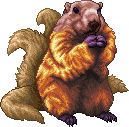Viewing AUy8P 8.9.36

Hardiness: 43
Appearance: 4
Emerged: 18:38 11.11.2024
Matured: 14:22 13.11.2024
Found in the Meza Stepo, a grassy steppe that also serves as home to the Stepa Safido, Ekvinoska Kavigo use the same camouflage techniques of brightly colored markings to blend into their vibrant surroundings. These stout herbivores live in vast burrows they dig using their powerful claws, emerging during the day to sunbathe and eat whatever foliage is available. They are not picky eaters and will graze on grass, flowers, and shrubs alike, though they have been observed to nibble on berries and even root vegetables, the latter especially during months when food is scarcer. From early spring until late fall, they display voracious eating habits, packing on the pounds in preparation for the winter months. As the temperatures grow colder, the Ekvinoska Kavigos retreat into their burrows to hibernate, not emerging again until around the spring equinox. Each burrow contains a colony of four to six family groups made up of a male and several females that stay together year-round. Most Ekvinoska Kavigo pups are born in the late spring, raised for a few weeks, and then may either stay with the colony or find a new one.
The creatures that dwell in this rather desolate world still display some diversity in appearance, eating habits, and social behavior. Whether they have fur or feathers, skin or scales, their unique genetic makeup allows for a variety of colors and markings within each species. Despite limitations in food sources, herbivores, omnivores, and carnivores are all present in the food chain, and each species requires specialized care within a laboratory. Although the artificial setting of housing units and breeding pods precludes most opportunities to study true interspecific behavior, the interactions within and between species has been studied extensively in the wilderness by scientists daring enough to venture beyond the outpost’s walls.
